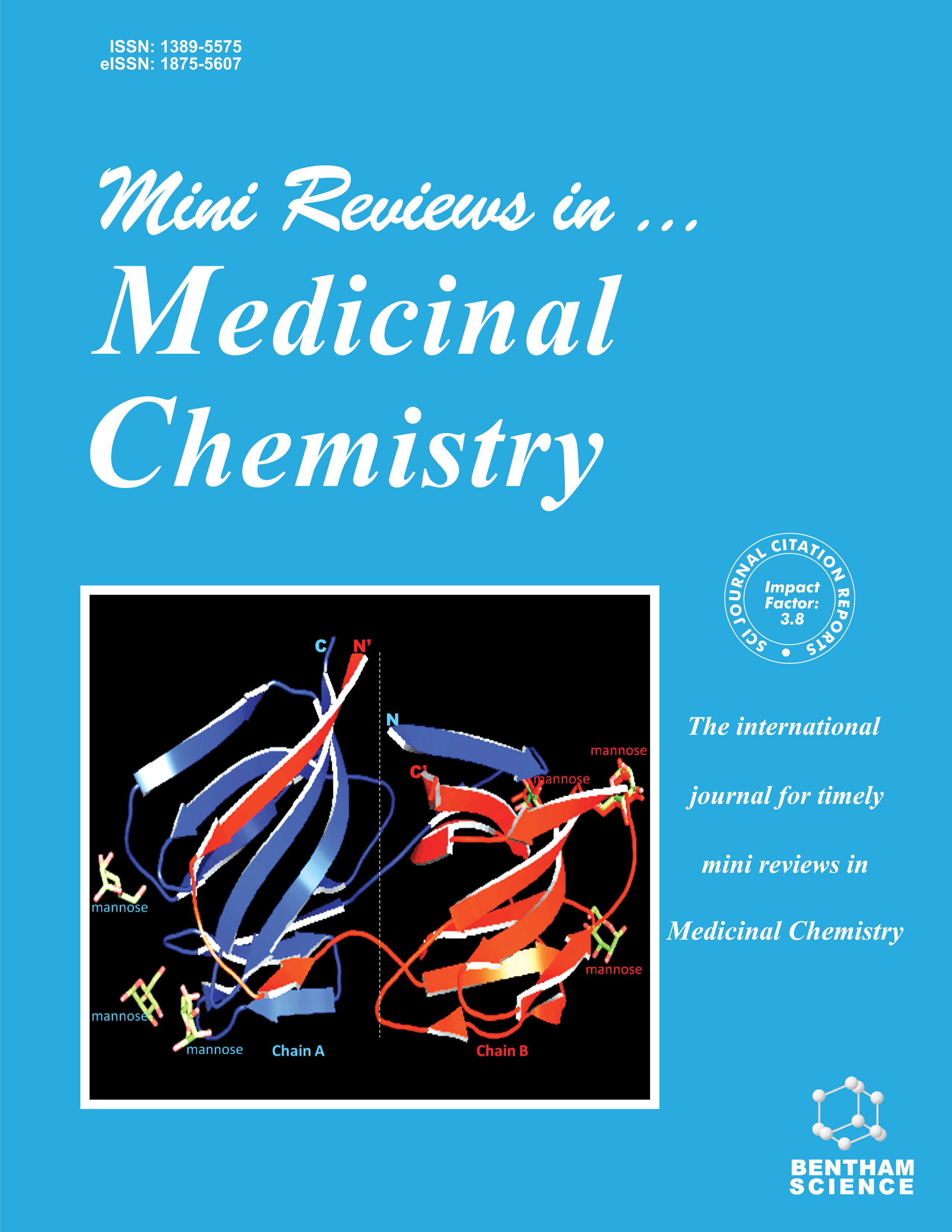- Home
- A-Z Publications
- Mini Reviews in Medicinal Chemistry
- Previous Issues
- Volume 21, Issue 14, 2021
Mini Reviews in Medicinal Chemistry - Volume 21, Issue 14, 2021
Volume 21, Issue 14, 2021
-
-
A Review of the Effects of Gold, Silver, Selenium, and Zinc Nanoparticles on Diabetes Mellitus in Murine Models
More LessDiabetes mellitus is a disease that presents great challenges for healthcare systems worldwide, and the identification of alternative therapies for the treatment of this disease is of vital importance. Metallic nanoparticles (gold, silver, and selenium) and metallic oxide (ZnO) have been studied in different areas such as medicine, biotechnology, the environment, and the food industry with promising results. In medicine, current res Read More
-
-
-
Limonene and Perillyl Alcohol Derivatives: Synthesis and Anticancer Activity
More LessLimonene and perillyl alcohol are natural monoterpenes that have attracted the attention of medicinal chemists due to their promising anticancer activities. Considering this, both compounds were explored as scaffolds to obtain various derivatives with anticancer activity. In this review, the data are organized for the first time, with a focus on the synthetic methods and strategies to obtain the derivatives throughout the period fro Read More
-
-
-
Cholesterol: Bioactivities, Structural Modification, Mechanisms of Action, and Structure-Activity Relationships
More LessAuthors: Kong Zhang, Tianze Li, Xijie Shan, Rongfei Lu, Shaoyong Zhang and Hui XuCholesterol, steroid alcohol, was discovered by M.E. Chevreul in 1815. Cholesterol and its derivatives showed a large variety of biological properties such as anticancer activity, anticardiac activity, anti-inflammatory activity, antimicrobial activity, anti-psychotic activity, antioxidant activity, drug-loaded activity, etc. In this mini-review, the advances of structural modification of cholesterol from 2014 to 2020 are summarized. In ad Read More
-
-
-
An Elite Scaffold and a Wonderful Pharmacophore in Drug Discovery: Styrylquinoline
More LessAuthors: Meenakshi Dhanawat, Dinesh K. Mehta and Rina DasStyrylquinoline is a quinoline molecule linked to phenyl rings with an unsaturated ethylene linker, resulting in a flat and rigid conformation. The synthesis of the molecule was reported almost a century ago but was not much explored due to its adverse toxicity and poor selectivity. In the last two decades, a plethora of work was reported related to the synthesis and antiretroviral activity of several styrylquinoline derivatives. La Read More
-
-
-
Selenium and Computational Studies
More LessAuthors: Natália F. de Sousa, Luciana Scotti, Eugene N. Muratov and Marcus Tullius ScottiBackground: Organocalcogens are a class of organic compounds obtained by the synthesis experiments to include S, Se, or Te. Among the elements that comprise this class, Se is characterized as an essential mineral and nutrient for humans. Se has been widely studied in many aspects. Organic synthesis of organoselenides is used for obtaining new potential drug candidates and may be highly beneficial from the use of c Read More
-
-
-
Recent Advances in Natural Products with Antiviral Activities
More LessAuthors: Zhi-Gang Sun, Zhi-Na Li, Xiang-Wan Miao, Shuang Li and Hai-Liang ZhuVirus is a type of noncellular organism, which is simple in structure, small in size and contains only one kind of nucleic acid (RNA or DNA). It must be parasitized in living cells and proliferates by replication. Viruses can infect plants or animals, which leads to many epidemic diseases, such as the current pandemic COVID-19. Viral infectious diseases have brought serious threats to the health of people around the world. Natural pro Read More
-
-
-
DNA Interaction and Cytotoxic studies on Mono/Di-Oxo and Peroxo- Vanadium (V) complexes - A Review
More LessAuthors: Saraswathi Kothandan and Angappan SheelaVanadium is considered to be biologically significant and several vanadium IV & V complexes have successfully been studied as chemotherapeutic agents like insulin mimetic, antibacterial, antioxidant, and anticancer activities. The divergent ligand systems also play a pivotal role in designing the metal complex with desired properties. Thus, the combination of both with their synergistic advantages results in a potential drug candid Read More
-
-
-
Adhatoda vasica (Nees.): A Review on its Botany, Traditional uses, Phytochemistry, Pharmacological Activities and Toxicity
More LessBackground: Adhatoda vasica (Nees.) of the family Acanthaceae has been used in the Southeast tropical zone as it is efficacious against headache, colds, cough, whooping cough, fever, asthma, dyspnea, phthisis, jaundice, chronic bronchitis, and diarrhea. It exhibits commendable pharmacological activities. Objective: The aim of the review is to provide a systematic overview of pharmacological activities with toxicit Read More
-
-
-
PRISMA Based Systematic Review: Pharmacognostic Study of Zanthoxylum armatum DC.
More LessAuthors: Sonia Singh, Aman Kumar and Bhupesh C. SemwalIntroduction: Herb, Zanthoxylum armatum DC., commonly called Indian prickly ash, and Nepal pepper (family Rutaceae), is widely utilized in the traditional medicinal system. Objective: The current review provides requisite data for collecting descriptive information on the organoleptic, microscopical, ethnobotanical use, and phytochemicals and pharmacological properties of Z. armatum; therefore, it may help in formin Read More
-
Volumes & issues
-
Volume 25 (2025)
-
Volume 24 (2024)
-
Volume 23 (2023)
-
Volume 22 (2022)
-
Volume 21 (2021)
-
Volume 20 (2020)
-
Volume 19 (2019)
-
Volume 18 (2018)
-
Volume 17 (2017)
-
Volume 16 (2016)
-
Volume 15 (2015)
-
Volume 14 (2014)
-
Volume 13 (2013)
-
Volume 12 (2012)
-
Volume 11 (2011)
-
Volume 10 (2010)
-
Volume 9 (2009)
-
Volume 8 (2008)
-
Volume 7 (2007)
-
Volume 6 (2006)
-
Volume 5 (2005)
-
Volume 4 (2004)
-
Volume 3 (2003)
-
Volume 2 (2002)
-
Volume 1 (2001)
Most Read This Month
Article
content/journals/mrmc
Journal
10
5
false
en


